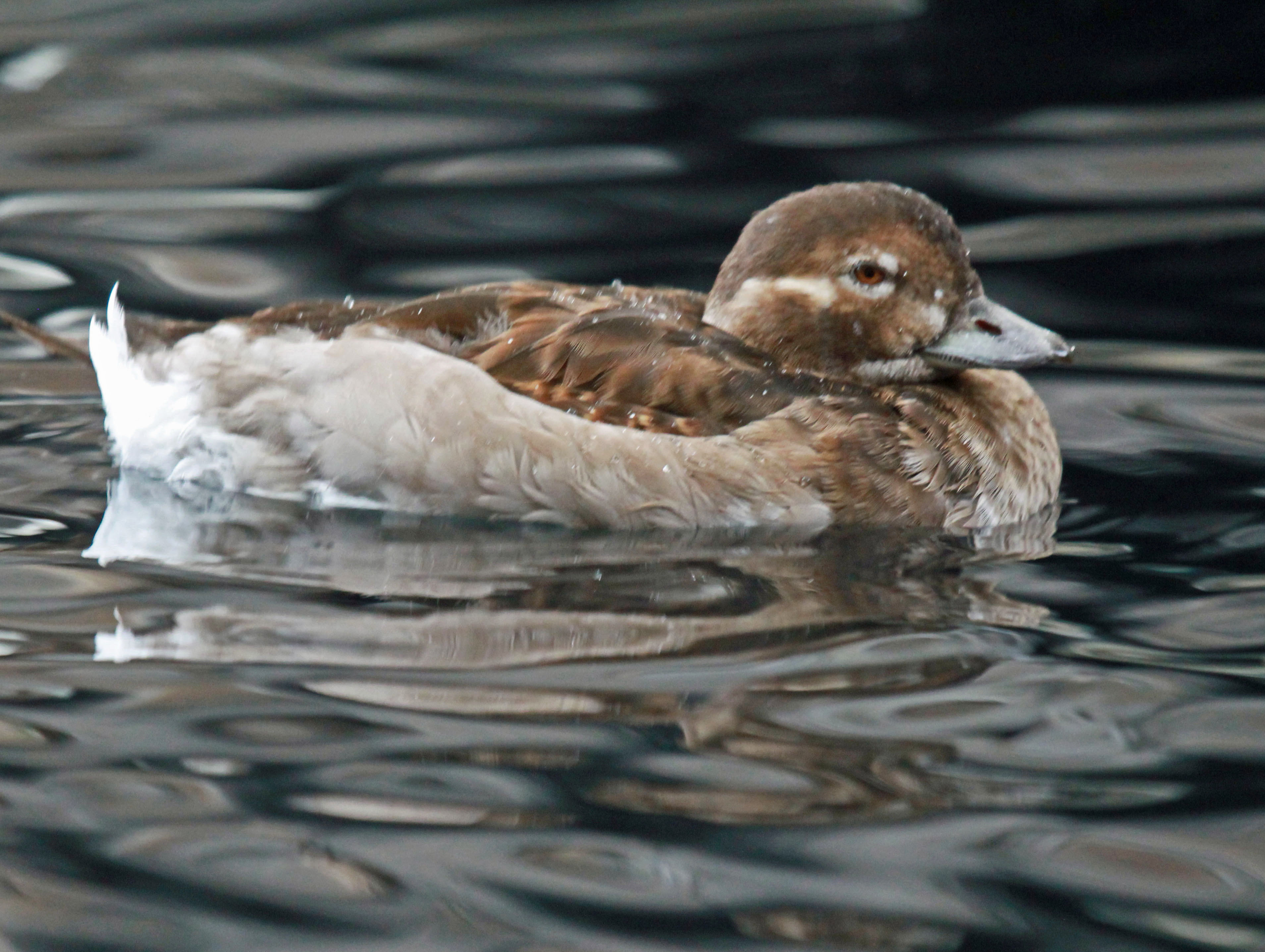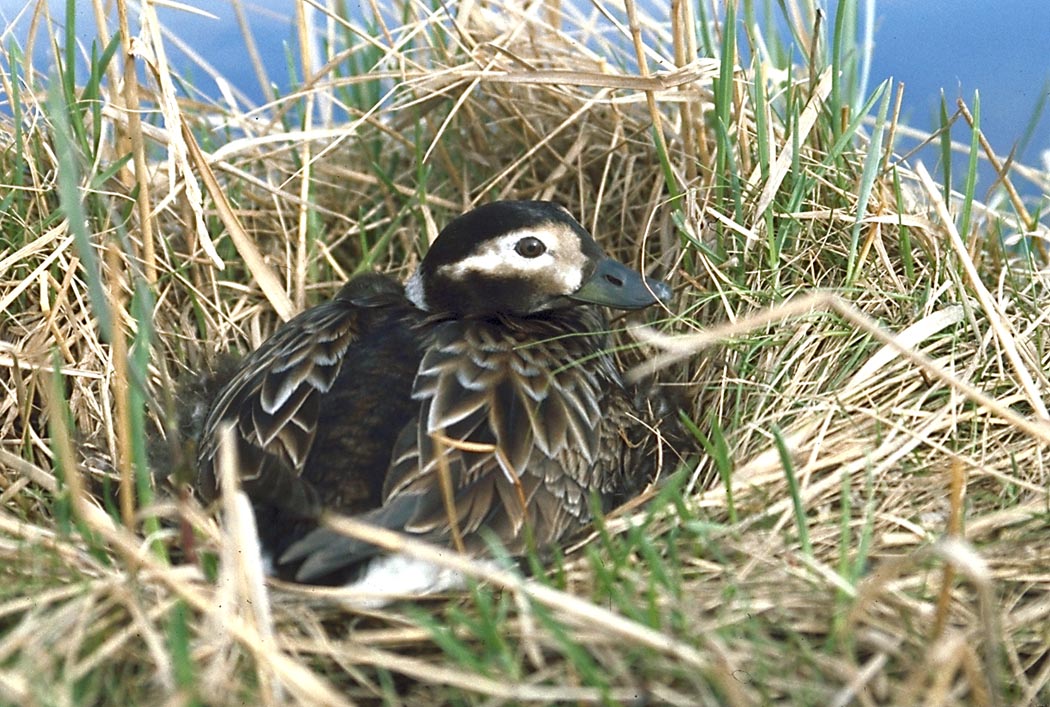The long-tailed duck was @SpeciesofUK from 10th to 16th
February 2013.
The long-tailed duck is a sea duck. Other sea
ducks found in UK waters include eiders, scoters, goldeneyes and mergansers.
 |
| Male Long-tailed Duck [Source: Rictor Norton & David Allen] |
The long-tailed duck is not resident in the
UK; it's a winter visitor. It's most common in estuaries and bays in northern
Scotland but is also seen as far south as Norfolk.
Habitat
Habitat
The long-tailed duck's habitat stretches
across the North Atlantic region, Alaska, northern Canada, northern Europe and
Russia. It breeds in tundra marshes/pools and large mountain lakes.
 |
| Male Long-tailed Duck [Source: Jan Svetlik] |
After the post-breeding moult, long-tailed
ducks gather for a large southward migration, around September. They mass in
huge, spectacular groups, and fly south to winter in bays,
estuaries, and occasionally on inland lakes.[1]
The most popular wintering site for the
long-tailed duck is the Baltic, which sees them gather together in the millions.
The UK is a bit of an outpost. Around 11,000 long-tailed ducks visit the UK in winter,
although they are concentrated around the north of Scotland.[2]
The global population of long-tailed duck is
estimated at 6.2-6.8 million individuals. The wintering population in the
Baltic has undergone a precipitous decline from 4.3m in 1992 to 1.5m in 2009.[3]
The main migration of birds home from the
Baltic, across the Gulf of Finland, is spectacular, with up to 100,000 birds
seen at once on late May evenings.[4]
 |
| Long-tailed Ducks Migrating in the Baltic [Source: Cano Vääri] |
Names
The long-tailed duck gets its name from ...
well, from the fact that it’s a duck with a long tail!
In North America, where the long-tailed duck
is common, it used to be known as the oldsquaw ("old wife"), a name
that may have come from a local belief that the spirits of old women pass into
sea ducks.[5]
“Oldsquaw” is now considered offensive and most
Americans have adopted long-tailed duck as the common name instead.
 |
| Long-tailed Duck or "Oldsquaw" [Source: Gidzy] |
Other regional American names for the
long-tailed duck include butterfly coot, Florida longtail, ice duck, singing
duck, sou-sou-sally, swallow-tailed duck and winter duck.[6]
In the UK, long-tailed duck is the only name
that is really used.
Identification
Identification
All in all, the long-tailed duck is a
relatively small sea duck. It has a rounded head and steep forehead.[7]
The greatly elongated tail feathers are only
found on the male, and they really are a marvel.
 |
| Male Long-tailed Duck [Source: Wolfgang Wander] |
Even aside from the tail, there is something
tasteful and well-ordered about the male's plumage. The female’s plumage is less exotic but it is
still an attractive bird.
 |
| Female Long-tailed Duck
[Source: DickDaniels]
|
Long-tailed ducks have a complex moult and
show a bewildering variety of patterns depending on their age, their sex and
the time of year.[8]
The colours are always a mixture of black, white and brown.
In total, the long-tailed duck's scapulars
and side of head and neck are moulted three times a year, the upper mantle and
rest of head twice a year, and the rest of the plumage once a year.[9]
 |
| Male Long-tailed Duck in Moult
[Source: DickDaniels]
|
Behaviour
During the summer, on the breeding ground, the
long-tailed duck eats aquatic insects and invertebrates and also some plant
material.[10]
In the winter, it eats a variety of marine
food, including crustaceans, molluscs, worms, and fish.[11]
A key food source of the long-tailed duck in
its favoured wintering site in the Baltic is the blue mussel, which is found
there in abundance.[12] It
swallow mussels whole, including the shell. Its digestive system crushes and
digests the shell and the soft body.[13]
The long-tailed duck is an expert diver,
regularly diving 20m when foraging and even down to an astonishing 60m, roughly
equivalent to the height of a 20-storey skyscraper![14]
 |
| Long-Tailed Duck Diving [Source: DaveMaherPhotos] |
While most diving ducks
paddle with their webbed feet, the long-tailed duck uses its partially folded
wings to propel itself underwater.[15] When foraging for food, it can spend 3 or 4 times as long
underwater as it does floating above water.[16]
While wintering out at sea, the long-tailed
duck is restless. It flies low over the water in short flights, with stiff and
shallow wing-beats, often tilting from side to side and constantly changing
direction.[17]
 |
| Long-tailed Ducks in Flight [Source: Eonian Art] |
The long-tailed duck has a distinctive
vocalisation, a nasal yodelling “ow ow-owdelee” which you can hear here.
Breeding
Breeding
Long-tailed duck pairs bond during the winter
or on the spring migration home. The bond lasts until incubation begins.[18]
The long-tailed duck breeds from late May, in
single pairs or in loose groups. They use a natural depression on dry ground in
the arctic tundra as a nest, usually close to water. They line it with leaves
and down.[19]
 |
| Female Long-tailed Duck on Nest [Source: Howcheng] |
The chicks leave the nest as soon as they are
dry from birth and then swim and feed themselves immediately, mainly on insect
larvae.[20] The
female helps dislodge food items for them but otherwise they feed themselves. At 35-40 days, the young start to fly.[21]
 |
| Female Long-tailed Duck with Chicks [Source: omarrun] |
The males leave the females after incubation
starts to gather together for a moult.[22] This is
basically a bit of a jolly. The leave the females and ducklings and in some
cases fly 1,000km for a temporary “moult migration.”[23]
The females, on the other hand, stay on the
breeding ground to moult, although they do sometimes gather in groups, leaving
their young together in a “creche.”[24]
Threats
The long-tailed duck population is in
decline. Its wetland habitat is threatened by drainage, peat extraction and
petroleum pollution.[25]
The long-tailed duck is susceptible to direct
pollution from oil, from being trapped in fishing nets, and from hunting, which
happens for example in Denmark and the USA.[26]
In 2006-07, in the Barents Sea, several
thousand dead long-tailed ducks were found washed up on beaches.[27]
Strange but true…
Most ducks land in water by using their feet
as brakes. The long-tailed duck doesn’t bother. It just belly-flops into the
water with an almighty splash.[28]
[4] Birds (Collins)
[9] Birds (Collins)
[17] Birds (Collins); http://www.birdweb.org/birdweb/bird/long-tailed_duck
No comments:
Post a Comment